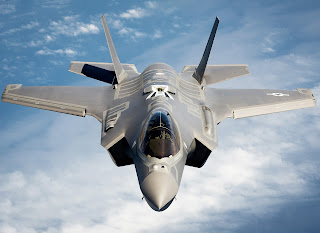The Lockheed Martin F-35 Lightning II is a family of single-seat, single-engine, all-weather stealth multirole fighters. The fifth-generation combat aircraft is designed to perform ground attack and air defense missions.
The F-35 has three main models: the F-35A conventional takeoff and landing (CTOL) variant, the F-35B short take-off and vertical-landing (STOVL) variant, and the F-35C carrier-based Catapult Assisted Take-Off Barrier Arrested Recovery (CATOBAR) variant. On 31 July 2015, the United States Marines declared ready for deployment the first squadron of F-35B fighters after intensive testing. On 2 August 2016, the U.S. Air Force declared its first squadron of F-35A fighters combat-ready.
The F-35 descends from the X-35, the winning design of the Joint Strike Fighter (JSF) program. An aerospace industry team led by Lockheed Martin designed and manufactures it. Other major F-35 industry partners include Northrop Grumman, Pratt & Whitney and BAE Systems. The F-35 first flew on 15 December 2006. The United States plans to buy 2,457 aircraft. Its variants are to provide the bulk of the crewed tactical airpower of the U.S. Air Force, Navy and the Marine Corps over the coming decades. Deliveries of the F-35 for the U.S. military are scheduled until 2037 with a projected service life up to 2070.
The United States principally funds the F-35 JSF development, with additional funding from partners. The partner nations are either NATO members or close U.S. allies. The United Kingdom, Italy, Australia, Canada, Norway, Denmark, the Netherlands, and Turkey are part of the active development program; several additional countries have ordered, or are considering ordering, the F-35.
Bloomberg Businessweek on 10 April 2017 reported the total procurement expenditures for the F-35 program as approaching one trillion dollars. The program is the most expensive military weapons system in history, and has been much criticized inside and outside government, in the U.S. and in allied countries. Critics argue that the plane is "plagued with design flaws," with many blaming the procurement process in which Lockheed was allowed "to design, test, and produce the F-35 all at the same time. instead of identifying and fixing defects before firing up its production line." By 2014, the program was "$163 billion over budget and seven years behind schedule." Critics also contend that the program's high sunk costs and political momentum make it "too big to kill". More details
The F-35 has three main models: the F-35A conventional takeoff and landing (CTOL) variant, the F-35B short take-off and vertical-landing (STOVL) variant, and the F-35C carrier-based Catapult Assisted Take-Off Barrier Arrested Recovery (CATOBAR) variant. On 31 July 2015, the United States Marines declared ready for deployment the first squadron of F-35B fighters after intensive testing. On 2 August 2016, the U.S. Air Force declared its first squadron of F-35A fighters combat-ready.
The F-35 descends from the X-35, the winning design of the Joint Strike Fighter (JSF) program. An aerospace industry team led by Lockheed Martin designed and manufactures it. Other major F-35 industry partners include Northrop Grumman, Pratt & Whitney and BAE Systems. The F-35 first flew on 15 December 2006. The United States plans to buy 2,457 aircraft. Its variants are to provide the bulk of the crewed tactical airpower of the U.S. Air Force, Navy and the Marine Corps over the coming decades. Deliveries of the F-35 for the U.S. military are scheduled until 2037 with a projected service life up to 2070.
The United States principally funds the F-35 JSF development, with additional funding from partners. The partner nations are either NATO members or close U.S. allies. The United Kingdom, Italy, Australia, Canada, Norway, Denmark, the Netherlands, and Turkey are part of the active development program; several additional countries have ordered, or are considering ordering, the F-35.
Bloomberg Businessweek on 10 April 2017 reported the total procurement expenditures for the F-35 program as approaching one trillion dollars. The program is the most expensive military weapons system in history, and has been much criticized inside and outside government, in the U.S. and in allied countries. Critics argue that the plane is "plagued with design flaws," with many blaming the procurement process in which Lockheed was allowed "to design, test, and produce the F-35 all at the same time. instead of identifying and fixing defects before firing up its production line." By 2014, the program was "$163 billion over budget and seven years behind schedule." Critics also contend that the program's high sunk costs and political momentum make it "too big to kill". More details


No comments:
Post a Comment